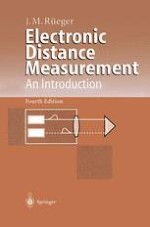1996 | OriginalPaper | Buchkapitel
Propagation of Electromagnetic Waves Through the Atmosphere
verfasst von : Dr. J. M. Rüeger
Erschienen in: Electronic Distance Measurement
Verlag: Springer Berlin Heidelberg
Enthalten in: Professional Book Archive
Aktivieren Sie unsere intelligente Suche, um passende Fachinhalte oder Patente zu finden.
Wählen Sie Textabschnitte aus um mit Künstlicher Intelligenz passenden Patente zu finden. powered by
Markieren Sie Textabschnitte, um KI-gestützt weitere passende Inhalte zu finden. powered by
The transmittance of the atmosphere is usually described by the quotient of incident radiant power divided by transmitted radiant power. It is a measure of the attenuation and extinction of wave propagation. The transmittance is a function of numerous variables: wavelength, distance, temperature, barometric pressure, gaseous mixture, rain, snow, dust, aerosols, bacteria and, in more detail, the size of particles of all these constituents. The limitations of atmospheric transmittance are given by the scattering and absorption of the emitted radiation. Scattering by air molecules (Rayleigh Scattering) and scattering by larger aerosol particles (Mie scattering) can be distinguished. Absorption in several spectral regions is mainly caused by water vapour, carbon dioxide and ozone. Figure 5.1 depicts the transmittance of atmosphere as a function of wavelength for a part of the visible and near-infrared (NIR) spectrum under specific conditions. The figure shows that only a limited part of the NIR spectrum is suitable for EDM.
